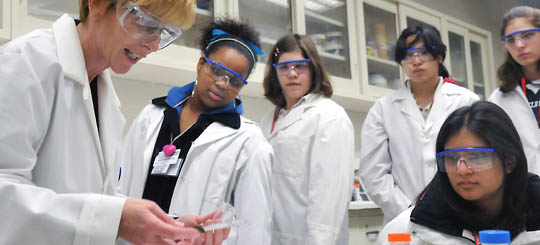How to Introduce Students to the Scientific Method
Students, and sometimes even teachers, often think scientists only use the scientific method to answer science-related questions. In fact, you can apply the scientific method to almost any problem. The key is to use the elements (steps) to reduce bias and help come to a solution to the problem.
One Size Does Not Fit All

The scientific method consists of a number of different steps, but the order in which we apply the steps can vary. Rather than focus on the order of the steps, students should see the scientific method as a tool that consists of elements they can use to solve problems and answer questions.
In fact, solving problems can lead students through the scientific method before they even realize it. We used this idea to design our Science Detectives Training Room game to help introduce the scientific method.
You can find more information on the game and how to implement it further down on this page. But first, let's look a bit into how exactly we're thinking about doing science more generally and how the scientific method fits into that.

While you can reorder the steps of the scientific method, it is important to apply all the steps to reduce the impact of personal bias. This is really the key function of the scientific method. The scientific method lays out a process that helps scientists come to a conclusion, but that conclusion is made more valid by virtue of the process scientists used to reach their conclusion. One of the real strengths of the scientific method is that its steps help users reduce the chance for error and personal bias, making the results of their experiments more trustworthy.
Steps Common to Versions of the Scientific Method
A quick Web search yields several different versions of the scientific method. Some have more steps, others have fewer steps. This can confuse students and teachers. Which one is correct? The short answer is most of them are correct.
The steps of the scientific method, no matter what sequence they are in (e.g., prediction before test, test before predictions) helps organize the thought processes and logic of resolving a problem or answering a question. But no matter which version of the scientific method someone uses, there will be some common steps:
- The search for alternative explanations
- Constant pressure to disprove even currently accepted hypotheses
- Capacity to modify or even drop a "favorite" hypothesis when too many exceptions become apparent (truth is relative to the available data)
Communicating What Is Learned
The scientific method also serves as an important template for communicating results and the logic behind them. This step is perhaps the most important step in the scientific method, yet it is often a step that is left out of models of the scientific method. If scientists don't share their results or talk about the processes they used to get those results, those results can't become part of our understanding of the world around us. It is, therefore, critical that "communicating results" is part of students' vision of the scientific method.
Science and the Scientific Method
Being involved in science and using the scientific method are not necessarily the same thing. It is possible to be involved in science without applying all the processes of the scientific method. The citizen science movement, which is a very powerful part of the science community, is a great example of this. Citizen scientists are ordinary folks who are involved with pieces of the scientific method, such as data collection.
For example, in the Monarch Monitoring Project, citizen scientists help count migrating monarch butterflies. Each year thousands of people from around the country spend time collecting critical butterfly census data. The Great Backyard Bird Count (GBBC) is another large citizen science project that relies on the help of people from around the country to collect bird data.
Collecting data is one part of the scientific method, and citizen scientists clearly “do science," but they have not applied all the parts of the scientific method. Students should understand that the scientific method is a process that results in a conclusion. Simply gathering data does not result in a conclusion; other steps are necessary.
Are You and Your Students Science Detectives?
Science Detectives Training Room is a fun way to teach students from elementary level to college about the scientific method. It is also a great way to build problem solving skills. Based on a popular "room escape" genre of online games, players enter a dark room and must work through a set of problems to escape.
Once the player escapes from the first room, they encounter a summary of the steps they took to escape and how those steps match the steps of the scientific method. At the end of the game the player can print out the results of their training room exercise for review. If used as an assignment, students can submit the printout to their instructor to show how they performed in the activity.
The game then connects to a follow-up game, The Case of the Mystery Images, which allows students to practice their new detective skills. They are shown a series of images that they have to make hypotheses about in order to progress through the game. They can also print out their work in this game.
Review First, Play Later, or Play First and Review Afterwards?
This is a question best answered by each teacher. Depending on the student or class, it might help to review the process involved in using the scientific method to solve problem. Previewing the game allows the student to experience what they have learned as they play the game. Other instructors, however, might choose to have students play the game first and then use the game summary printout as a tool for engaging students in a discussion of the process and parts of the scientific method, such as control, variables, and data. Either method is effective.

Time to Play
The average time to play the game is 5-7 minutes, depending on the grade level of the student.
Multiple Game Solutions
The game has multiple options that are randomly selected as the player enters the room. Players are unlikely to have the same experience if they play the game several times.

This is handy for instructors who want to have students play the game in a classroom laboratory. Each student is likely to have a slightly different experience.
Using the Final Report Option
In order to escape, a player will be presented an opportunity to print the output of their training. The final report is personalized and can be used as homework or as an extra credit opportunity.
Arizona Science Standards
Strand One: Inquiry process
Concept 1: Observations, Questions, and Hypotheses
- PO 1. (5) Formulate a relevant question through observations that can be tested by an investigation.
- PO 1. (6) Differentiate among a question, hypothesis, and prediction.
- PO 1. (7) Formulate questions based on observations that lead to the development of a hypothesis.
- PO 1. (8) Formulate questions based on observations that lead to the development of a hypothesis.
- PO 2. (5) Formulate predictions in the realm of science based on observed cause and effect relationships.
- PO 3. (7) Explain the role of a hypothesis in a scientific inquiry.
Concept 3: Analysis and Conclusions
- PO 2. (3) Construct reasonable interpretations of the collected data based on formulated questions.
Common Core Standards
- CCSS.ELA-LITERACY.RST.6-8.10. By the end of grade 8, read and comprehend science/technical texts in the grades 6-8 text complexity band independently and proficiently.
Read more about: Using the Scientific Method to Solve Mysteries
Bibliographic details:
- Article: For Teachers
- Author(s): Dr. Biology
- Publisher: Arizona State University School of Life Sciences Ask A Biologist
- Site name: ASU - Ask A Biologist
- Date published: 23 Feb, 2013
- Date accessed:
- Link: https://askabiologist.asu.edu/teaching-scientific-method
APA Style
Dr. Biology. (Sat, 02/23/2013 - 08:50). For Teachers. ASU - Ask A Biologist. Retrieved from https://askabiologist.asu.edu/teaching-scientific-method
Chicago Manual of Style
Dr. Biology. "For Teachers". ASU - Ask A Biologist. 23 Feb 2013. https://askabiologist.asu.edu/teaching-scientific-method
Dr. Biology. "For Teachers". ASU - Ask A Biologist. 23 Feb 2013. ASU - Ask A Biologist, Web. https://askabiologist.asu.edu/teaching-scientific-method
MLA 2017 Style

Perfect for students and teachers. Science Detectives Training Room introduces the scientific method in a fun game format. Do you think you can escape?
Be Part of
Ask A Biologist
By volunteering, or simply sending us feedback on the site. Scientists, teachers, writers, illustrators, and translators are all important to the program. If you are interested in helping with the website we have a Volunteers page to get the process started.

